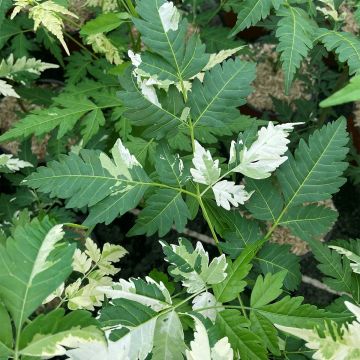

Melia azedarach - Margousier
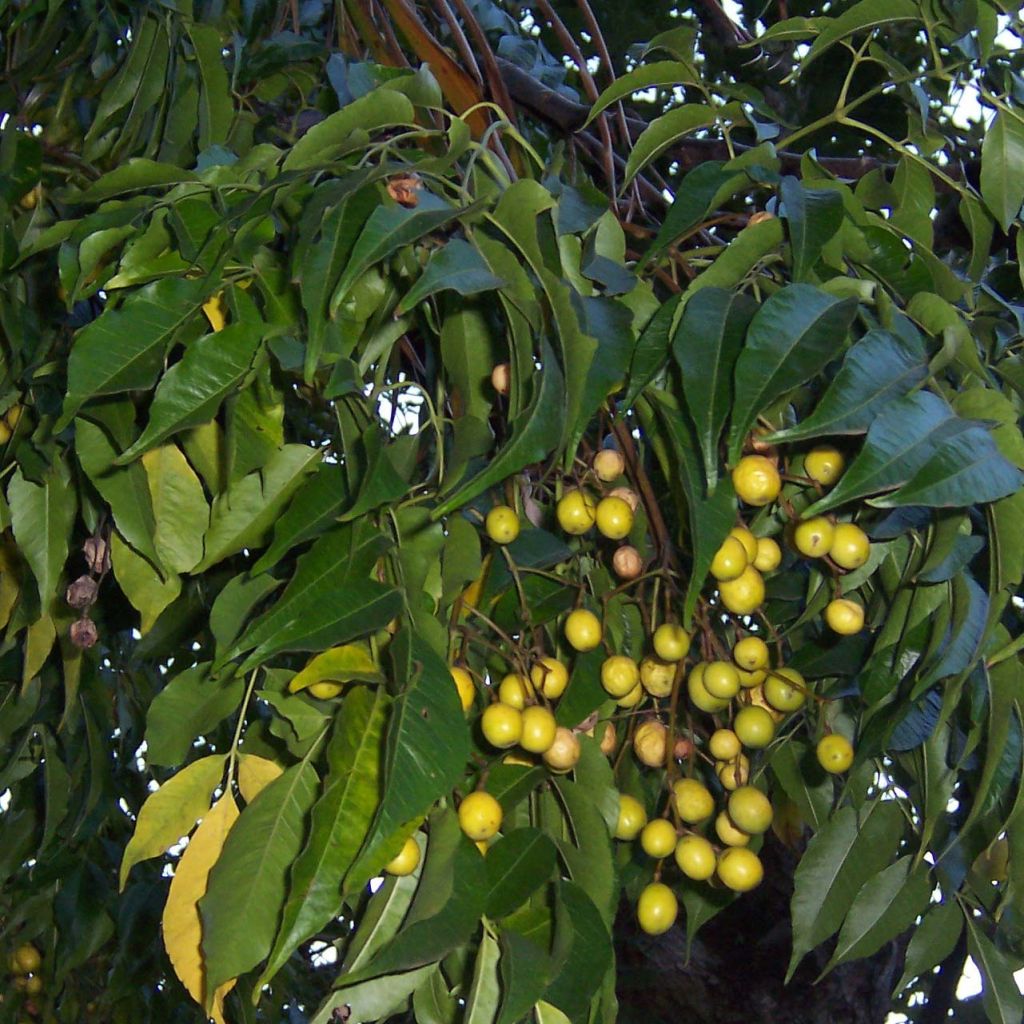

Melia azedarach - Margousier
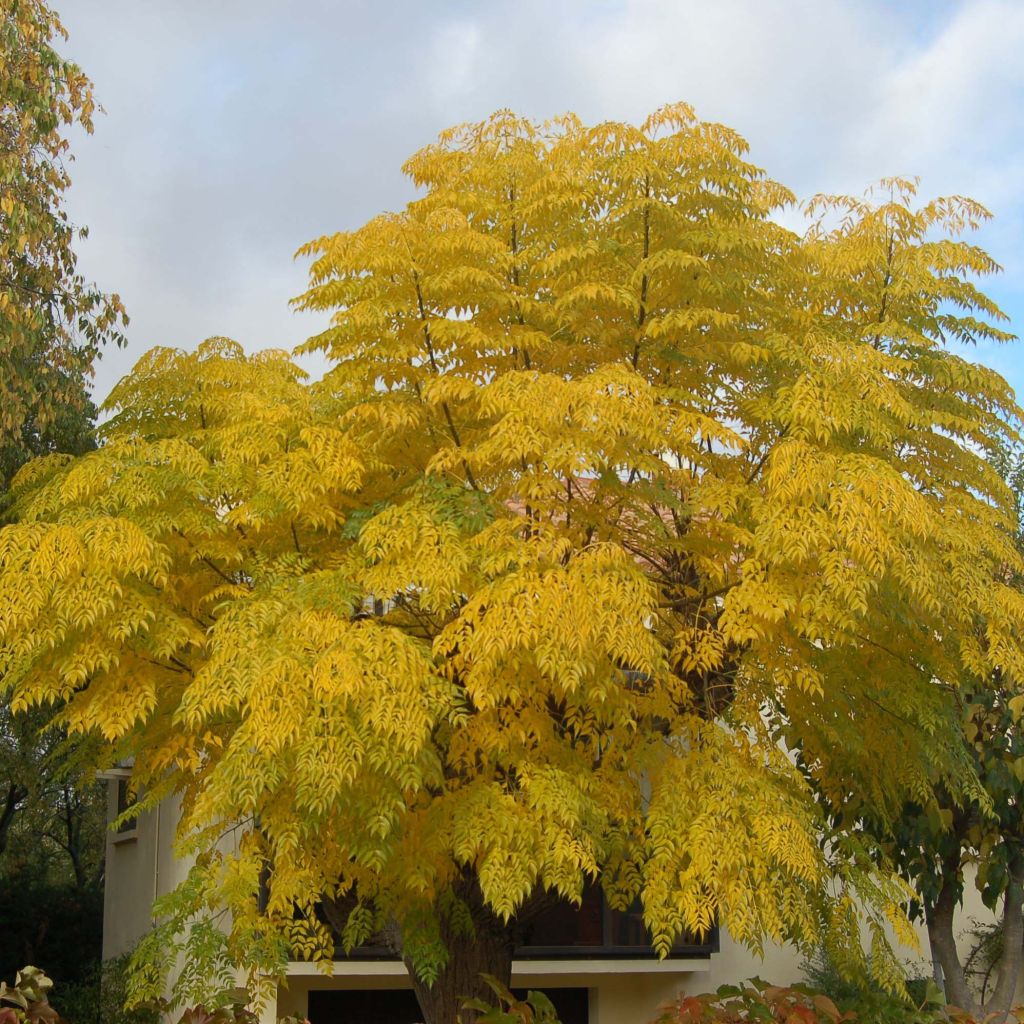

Melia azedarach - Margousier


Melia azedarach - Margousier
Melia azedarach
Melia azedarach
Chinaberry Tree, Bead Tree, Cape Lilac, Persian Lilac
Special offer!
Receive a €20 voucher for any order over €90 (excluding delivery costs, credit notes, and plastic-free options)!
1- Add your favorite plants to your cart.
2- Once you have reached €90, confirm your order (you can even choose the delivery date!).
3- As soon as your order is shipped, you will receive an email containing your voucher code, valid for 3 months (90 days).
Your voucher is unique and can only be used once, for any order with a minimum value of €20, excluding delivery costs.
Can be combined with other current offers, non-divisible and non-refundable.
This plant carries a 24 months recovery warranty
More information
We guarantee the quality of our plants for a full growing cycle, and will replace at our expense any plant that fails to recover under normal climatic and planting conditions.
Would this plant suit my garden?
Set up your Plantfit profile →
Description
Melia azedarach has various names such as Chinaberry tree, Persian lilac, or Ceylon mahogany. Cultivated for centuries as a temple tree in Persia, Ceylon, and Malaysia, this small ornamental and useful tree has made its way through the centuries, from the arid regions of the Himalayas to the Mediterranean region. Spared by insects and diseases, it charms with its light and fragrant flowering, reminiscent of lilac, and then with its honey-coloured fruits that persist on the branches in winter. In the absence of being spectacular, it presents an undeniable advantage for gardeners: its extreme robustness, coupled with an undemanding nature. This deciduous shrub thrives in any well-drained soil and in any exposure, with only one weakness: it fears very cold winters.
The genus Melia, belonging to the Meliaceae family, has only one species, Melia azedarach, widely distributed in Asia, from Iraq to Japan, southern China to Australia, eastern Africa, and the Mediterranean basin. This species is quite polymorphic depending on its environment. It is native to the southern Himalayas (Baluchistan and Kashmir). It owes its nickname "Chinaberry tree" to the use that was made in the past of its naturally pierced fruit stones. It is also called Ceylon mahogany, as it is a close relative of other mahogany trees (Khaya, Swietenia, Dysoxylum), tropical trees highly prized in cabinet-making. The lifespan of Melia azedarach reaches 200 years and its growth is very fast, at least during the first years. It is hardy in zone 8, down to -12 to -15°C (10.4 to 5°F).
This small tree has a spreading habit with a rounded and airy crown. It reaches an average height of 9m (29ft) with a spread of 3m (10ft). Its bark is greyish-brown, smooth, and cracks longitudinally with age, revealing a wood of ochre colour, while the young branches are slightly tinged with red. Its root system is extensive and it can sucker at a distance, like the strawberry tree. Its foliage falls in autumn and reappears late in spring, at the same time as the flowering. It consists of long leaves reaching 25 to 45cm (10 to 18in) in length, divided into numerous ovate and pointed leaflets with more or less toothed edges. They are a bright green, shiny on the upper side, lighter underneath, and then turn yellow before falling in autumn. When crushed, the leaves give off an odour that can be unpleasant, due to the presence of insecticidal compounds. The flowering takes place in May-June, earlier or later depending on the climate. It appears as loose panicles measuring 20 to 25cm (8 to 10in) long, emerging from the leaf axils on the current year's branches. These fragrant clusters are formed by numerous small tubular and star-shaped flowers with 5 petals, about 1.5 to 2cm (1in) wide, and light lilac in colour. The corolla tube is a deeper violet, and the anthers are yellow. This flowering gives way to clusters of round fruits, about 1.5cm (1in) in diameter, which are initially acidic green, becoming honey-yellow when ripe. They persist on the branches long after the leaves have fallen, delighting birds and bats that disperse the seeds. The hard, oval, ribbed fruit stone is naturally pierced like a pearl. It contains 6 chambers with 6 seeds that resemble brown rice grains.
Melia azedarach is not one of those shrubs that you dream of acquiring at all costs, but it is not devoid of charm, and it is valuable for bringing a touch of luxuriance to the barren or wild areas of the garden, even in dry and poor soil. It stands out during flowering, then fades into the background until winter when its fruits attract attention. It can be planted in a border or an informal hedge with other undemanding shrubs such as the Bee Bee tree, Elaeagnus, wild roses, strawberry trees, elderberries, pyracantha, Tetraclinis, large viburnums, and many others.
Properties, uses:
In Italy, it was once cultivated to make rosary beads from its stones. The oily seeds produce oil used in soaps, waxes, lubricants, as well as a vermifuge and for treating certain liver and kidney disorders. Its foliage is used as fodder. This medicinal plant is highly appreciated in Ayurvedic medicine.
The shrub also has quality wood, ranging in colour from yellowish-pink to dark red. It is rot-resistant, with a fine grain. It is called "Ceylon mahogany" and resembles teak (Tectona grandis).
Report an error about the product description
Melia azedarach in pictures


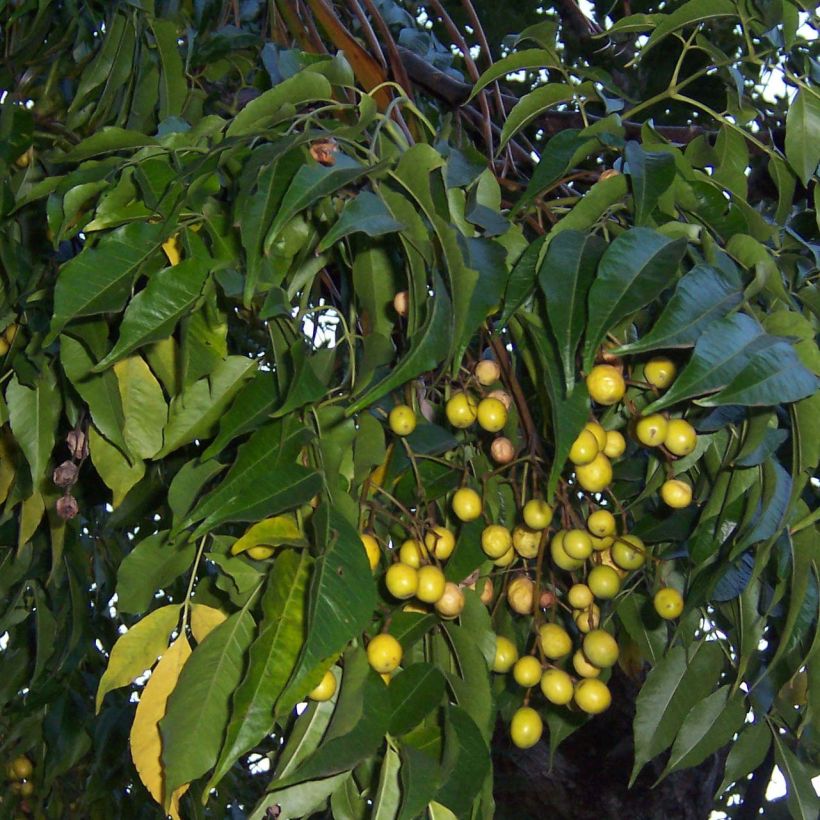

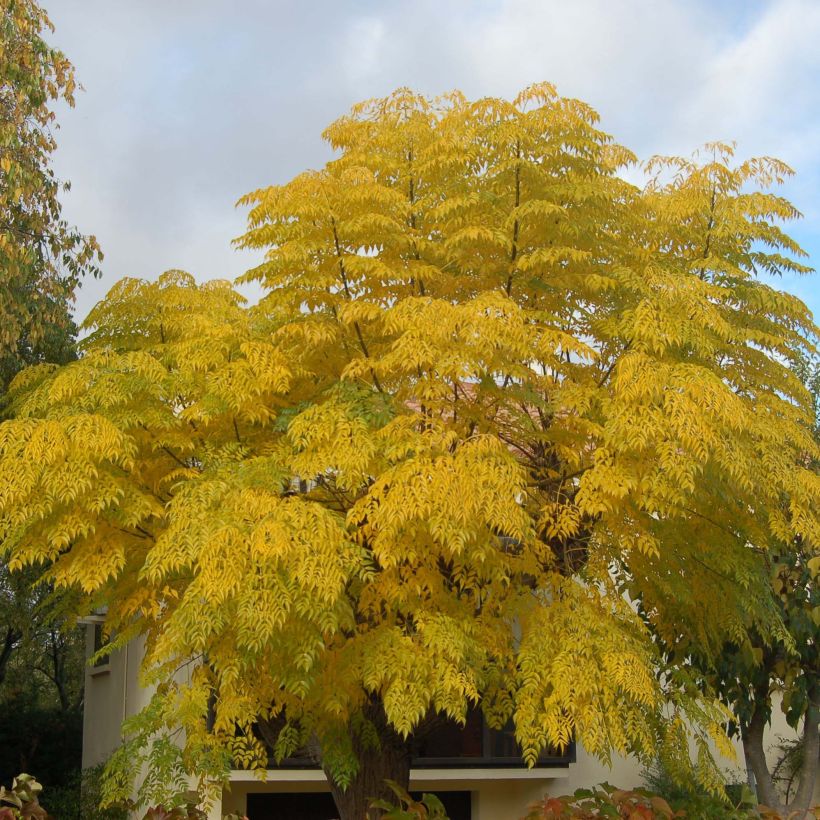

Plant habit
Flowering
Foliage
Botanical data
Melia
azedarach
Meliaceae
Chinaberry Tree, Bead Tree, Cape Lilac, Persian Lilac
Himalayas
Other Melia - Chinaberry
View all →Planting and care
Plant in spring, or in autumn in mild climates. Plant it in well-prepared ordinary soil. This bush accepts all properly drained soils, slightly acidic, neutral, or slightly calcareous. It prefers deep soils, not too poor and slightly moist, but it adapts perfectly to poor, mediocre, and dry soils in summer once established. Choose a location sheltered from strong winds, as its wood is quite brittle. A broken tree lying on the ground will regrow from the stump. Monitor watering to help it establish. Watch for the appearance of suckers, which can emerge at a distance from the stump when the tree has been damaged by the wind, a severe cut at the base of the trunk, or intense cold.
Planting period
Intended location
Care
Planting & care advice
This item has not been reviewed yet - be the first to leave a review about it.
Haven't found what you were looking for?
Hardiness is the lowest winter temperature a plant can endure without suffering serious damage or even dying. However, hardiness is affected by location (a sheltered area, such as a patio), protection (winter cover) and soil type (hardiness is improved by well-drained soil).

Photo Sharing Terms & Conditions
In order to encourage gardeners to interact and share their experiences, Promesse de fleurs offers various media enabling content to be uploaded onto its Site - in particular via the ‘Photo sharing’ module.
The User agrees to refrain from:
- Posting any content that is illegal, prejudicial, insulting, racist, inciteful to hatred, revisionist, contrary to public decency, that infringes on privacy or on the privacy rights of third parties, in particular the publicity rights of persons and goods, intellectual property rights, or the right to privacy.
- Submitting content on behalf of a third party;
- Impersonate the identity of a third party and/or publish any personal information about a third party;
In general, the User undertakes to refrain from any unethical behaviour.
All Content (in particular text, comments, files, images, photos, videos, creative works, etc.), which may be subject to property or intellectual property rights, image or other private rights, shall remain the property of the User, subject to the limited rights granted by the terms of the licence granted by Promesse de fleurs as stated below. Users are at liberty to publish or not to publish such Content on the Site, notably via the ‘Photo Sharing’ facility, and accept that this Content shall be made public and freely accessible, notably on the Internet.
Users further acknowledge, undertake to have ,and guarantee that they hold all necessary rights and permissions to publish such material on the Site, in particular with regard to the legislation in force pertaining to any privacy, property, intellectual property, image, or contractual rights, or rights of any other nature. By publishing such Content on the Site, Users acknowledge accepting full liability as publishers of the Content within the meaning of the law, and grant Promesse de fleurs, free of charge, an inclusive, worldwide licence for the said Content for the entire duration of its publication, including all reproduction, representation, up/downloading, displaying, performing, transmission, and storage rights.
Users also grant permission for their name to be linked to the Content and accept that this link may not always be made available.
By engaging in posting material, Users consent to their Content becoming automatically accessible on the Internet, in particular on other sites and/or blogs and/or web pages of the Promesse de fleurs site, including in particular social pages and the Promesse de fleurs catalogue.
Users may secure the removal of entrusted content free of charge by issuing a simple request via our contact form.
The flowering period indicated on our website applies to countries and regions located in USDA zone 8 (France, the United Kingdom, Ireland, the Netherlands, etc.)
It will vary according to where you live:
- In zones 9 to 10 (Italy, Spain, Greece, etc.), flowering will occur about 2 to 4 weeks earlier.
- In zones 6 to 7 (Germany, Poland, Slovenia, and lower mountainous regions), flowering will be delayed by 2 to 3 weeks.
- In zone 5 (Central Europe, Scandinavia), blooming will be delayed by 3 to 5 weeks.
In temperate climates, pruning of spring-flowering shrubs (forsythia, spireas, etc.) should be done just after flowering.
Pruning of summer-flowering shrubs (Indian Lilac, Perovskia, etc.) can be done in winter or spring.
In cold regions as well as with frost-sensitive plants, avoid pruning too early when severe frosts may still occur.
The planting period indicated on our website applies to countries and regions located in USDA zone 8 (France, United Kingdom, Ireland, Netherlands).
It will vary according to where you live:
- In Mediterranean zones (Marseille, Madrid, Milan, etc.), autumn and winter are the best planting periods.
- In continental zones (Strasbourg, Munich, Vienna, etc.), delay planting by 2 to 3 weeks in spring and bring it forward by 2 to 4 weeks in autumn.
- In mountainous regions (the Alps, Pyrenees, Carpathians, etc.), it is best to plant in late spring (May-June) or late summer (August-September).
The harvesting period indicated on our website applies to countries and regions in USDA zone 8 (France, England, Ireland, the Netherlands).
In colder areas (Scandinavia, Poland, Austria...) fruit and vegetable harvests are likely to be delayed by 3-4 weeks.
In warmer areas (Italy, Spain, Greece, etc.), harvesting will probably take place earlier, depending on weather conditions.
The sowing periods indicated on our website apply to countries and regions within USDA Zone 8 (France, UK, Ireland, Netherlands).
In colder areas (Scandinavia, Poland, Austria...), delay any outdoor sowing by 3-4 weeks, or sow under glass.
In warmer climes (Italy, Spain, Greece, etc.), bring outdoor sowing forward by a few weeks.






























